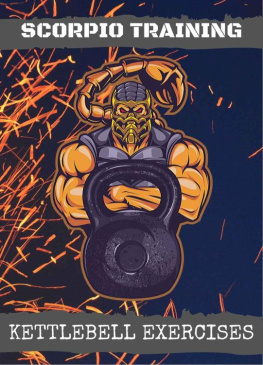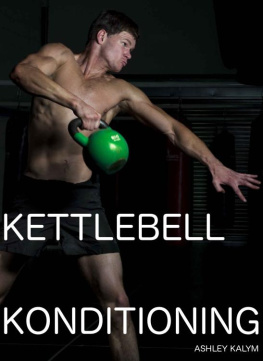INTRODUCTION
Getting in shape is something we always promise ourselves to do but somehow never get around to. How about if there were a quick, fun and relatively easy way to accomplish it, though?
With kettlebells , virtually anyone with any beginning level of fitness can develop a more toned , flexible body while losing weight . In as little as 30 days, it is possible to see results and not feel as though you are submitting yourself to torture!
Kettlebells , those funny looking pieces of equipment that may be collecting dust in the corner of a gym, provide a dynamic full-body workout that can give you great results in less time and with greater convenience than traditional exercise programs. There are two reasons for this:
kettlebells create an off-balance resistance that forces the cooperation of more muscles and muscle groups to burn a lot more calories and, most importantly, they are a lot of fun!
From what began as an activity to pass the time at farmers markets in Russia, the use of kettlebells has spread to gyms and workout rooms around the world. Given a wide variety of weights officially measured in poods (roughly 16 pounds), people of all ages and physical conditions can add kettlebell exercises to any traditional workout routine or even physical therapy program.

Simple, gentle lifts and swings can turn into dynamic, ballistic moves that demand tremendous coordination, flexibility and strength . With the mastery of the deadlift and swing , you are on your way to developing as wide a variety of exercises as you want in order to incorporate practically every muscle in your body. For this reason, kettlebell training has successfully been added to the workouts of professional and competitive athletes as well as body builders for increased power, explosive strength and muscle toning.
Kettlebells are essentially easy to use, but as with any new exercise program, it is important to discuss your overall health and fitness with a medical professional first. Additionally, proper form is crucial to the success of kettlebell training so a session or two with a certified instructor is the best way to start.
The information contained in this book is designed to provide you with the basic facts you need to get started on a 30 plan to a better, fitter body and lower weight . It is not intended as medical advice or to offer any guarantee. What it does, however, is to motivate you take the steps needed for improving your health and fitness, providing simple to follow instructions for beginning a terrific new exercise regimen.
Happy kettlebelling!

CHAPTER 1 WHAT IS KETTLEBELL TRAINING?
K ettlebell training was once associated with circus strongmen but has now become a standard tool for both men and women in the quest for total-body fitness and increased strength. Kettlebells are great for standard weight lifting workouts but have also been proven to be quite effective for cardio training and can be used in High Intensity Interval Training (HIIT) or physical therapy programs as well.
HISTORY OF THE KETTLEBELL
E vidence exists that kettlebells were used for competition in Ancient Greece.
Some people believe that kettlebells as exercise tools are derived from Scottish curling stones which were used for sport as early as the 1500s. More recently, however, kettlebells are mentioned in a Russian dictionary dating back to 1704 and are referred to as weights used to measure grain, produce and other goods. It is believed that farmers and other fair and festival participants began lifting and swinging these weights to demonstrate strength and the competitive sport of kettlebelling was born.
In terms of exercise and legitimate sport, Dr. Vladislav Kraevsky is credited as the developer of the use of kettlebells for strength and weight training. In 1885, a facility dedicated to weight training and systematic muscular development was opened in Russia based on the findings of Dr. Kraevsky who had searched throughout Russia and Europe to uncover as much information as possible about exercise practices and programs.
As evidence of the success of Kraevskys program spread, the use of kettlebells increased around the world. A number of world famous strong men have been pictured holding kettlebells. The advent of the Russian Revolution, WWI and subsequent political considerations caused the relative isolation of kettlebell usage to Russia where the sport continued to grow and the benefits of using kettlebells for exercise became more and more apparent.
With the opening of international borders at the end of the 20th century and the spread of sport competition around the world, kettlebelling as a sport is recognized today and overseen by a number of different organizations such as the:
American Kettlebell Club (AKC)

Canadian Kettlebell Sport Federation (CKSF)

International Girya Sport Federation (IGSF)

International Kettlebell & Fitness Federation (IKFF)

International Union of Kettlebell Lifting (IUKL)

World Kettlebell Club (WKC)

SCIENCE BEHIND KETTLEBELL TRAINING
I nstead of training isolated muscles, kettlebell training is a functional training activity . That means that the moves and demands of daily life or common sports are copied with the exercises done with the kettlebell. Lifting, pushing, pulling and reaching are all part of the kettlebell activities.
Why are kettlebells better than other weight training activities?
One advantage of kettlebells over dumbbells, barbells and machines is the dynamic, ballistic nature of the moves . You can work slowly or quickly with kettlebells to perform a wide range of movements that are either not possible with standard weights or would require many different machines.













![Cotter - Kettlebell training: [95 exercises for strength, toning, stamina, and weight loss]](/uploads/posts/book/196732/thumbs/cotter-kettlebell-training-95-exercises-for.jpg)









